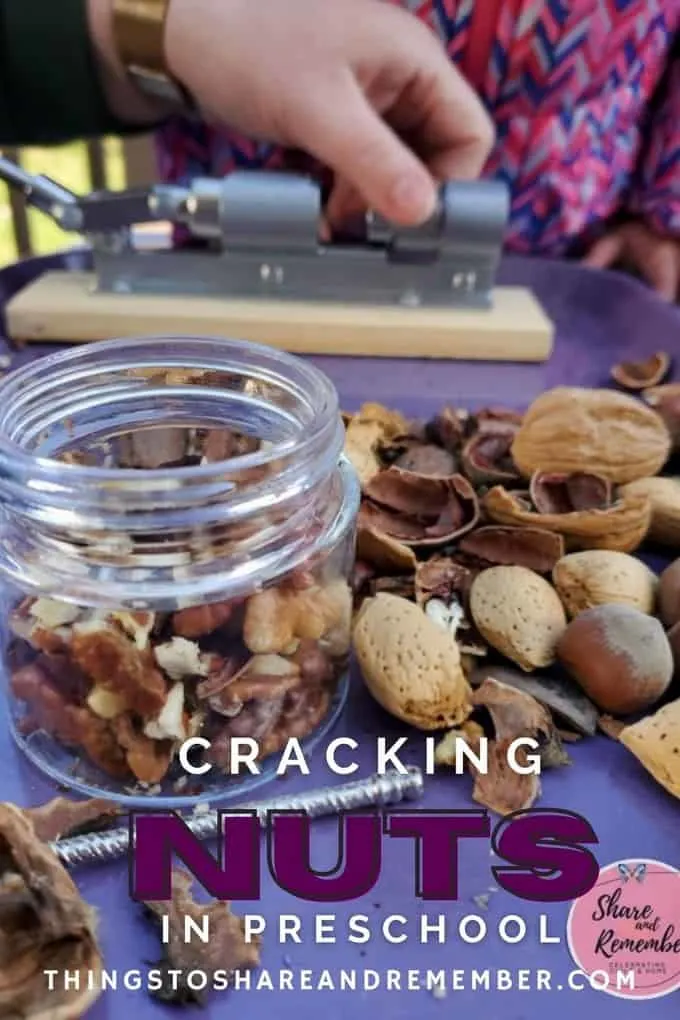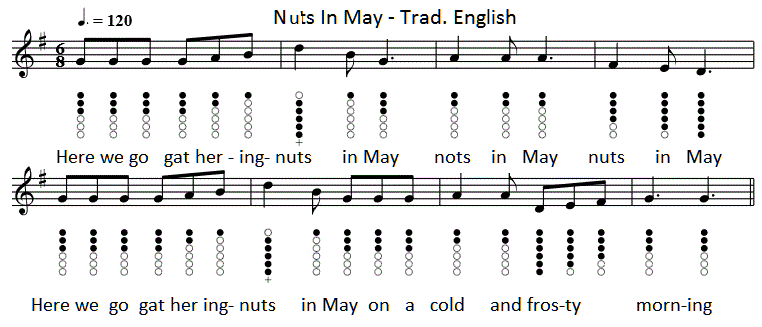Nuts in May is an English children’s singing and line game or dance sung to the tune of Here We Go Round the Mulberry Bush.
One question some children have about the song is why it mentions the gathering of nuts in May. Nuts only ripen in the autumn and not in May.

Let’s dive deep into the song’s history to understand that and much more.
LYRICS
Lyrics for Nuts In May as Sung Today
Nuts in May comprises five verses sung to the tune of Here We Go Round the Mulberry Bush. The last line in each stanza is precisely the same as Here We Go Round the Mulberry Bush.
Here we go gathering nuts in May,
Nuts in May, nuts in May.
Here we go gathering nuts in May,
On a cold and frosty morning.
Who will you have for nuts in May?
Nuts in May, nuts in May?
Who will you have for nuts in May?
On a cold and frosty morning.
We’ll have [name] for nuts in May,
Nuts in May, nuts in May,
We’ll have [name] for nuts in May,
On a cold and frosty morning.
Who will you send to fetch her away?
Fetch her away, fetch her away?
Who will you send to fetch her away?
On a cold and frosty morning?
(names) will fetch her away,
Fetch her away, fetch her away.
(Names) will fetch her away,
On a cold and frosty morning.
On a cold and frosty morning.
On a cold and frosty morning.
Full Original Lyrics for Nuts In May Nursery Rhyme
The original lyrics for the song only changed the word nuts into knots. Here is how the first verse would be.
Here we go gathering knots in May,
Knots in May, knots in May.
Here we go gathering knots in May,
On a cold and frosty morning.
There is also a link to a drinking song, which hints a bit more at the origin of the song and dance.
I took to gathering nuts in May,
nuts in May, nuts in May,
Down by the old mill stream.
But instead of gathering nuts in May,
I put her in a family way,
Down by the old mill stream.
We will discuss how knots became nuts in the song’s history below.
THE HISTORY BEHIND NUTS IN MAY
Who Wrote The Nursery Rhyme Nuts in May?
The writer of this age-old rhyme is unknown. According to Peter Walker, the song could have originated in medieval times or earlier. It isn’t easy to know who originally wrote the song with all that time in between.
However, Alice Gomme first recorded it between 1894 and 1898 in a book called The Traditional Games of England, Scotland, and Ireland. The book discussed the different children’s singing games across Britain.
Alice, in the book, speculated on the song’s origins and expressed disagreement with nuts being the collectibles. She suggested the song sings about gathering knots rather than nuts since nuts don’t ripen in May.
The correlation to the knots, or blossoming flowers, credits G. F Northall in his book, English Folk-rhymes of 1882. Northall had suggested the song was probably about practices that occurred during May Day Ceremonies.
Different lines by which the song ended seemed to lend credence to that theory. The alternative last lines were “on a May morning early” and “so early in the morning.” In medieval times, the gathering of flower posies during May Day was a widespread practice.
The link to knots is that a bunch of posies was called a knot, so you would gather a knot of posies in May usually to give to someone you liked or wished to marry!
Just when that changed to nuts is unclear.
When Did The Song Cross Into the US?
It is unclear when the song first landed in the US. When Alice Gomme wrote her book in 1894, the song was widespread in the US. Its popularity wasn’t as much as it was in Britain, though.
In his 1884 book Games and Songs of American Children, William Wells Newell described the song as a recent importation from Britain. That further goes to show how difficult it is to pin point the song’s origin is.
WHAT DO THE WORDS MEAN? DEFINITIONS

What Does the Nursery Rhyme Nuts in May Mean?
The nursery rhyme Here We Go Gathering Nuts in May could be about the practice of gathering knots of posies or bunches of flowers to give to a beau in May.
What Are Nuts?
Nuts are a fruit with a hard outer shell you need to break to access the inner edible part called the kernel. An example of a nut is the hazelnut.
What’s a Cold and Frosty Morning?
A cold and frosty morning is one with chilly, freezing weather typical of winter.
What does it mean to fetch?
To fetch, means to get something or someone. The fetch away is to take that thing or person away. Fetch in the song could also refer to marrying someone.
INTERESTING FACTS & QUESTIONS ANSWERED
Can You Really Gather Nuts in May?
Though the song suggests that people gather nuts in May, that’s not true in the Northern Hemisphere where the song originated. In the UK in May, nuts aren’t much larger than a bud since they are far from maturity.
The prevailing suggestion is that the song wasn’t originally about the collection of nuts. Instead, it was about the collection of knots, another name for a bunch of the flower posies.
Young people would go out collecting flower posies as part of preparations for the celebration of May Day in medieval times. However the knot was to be given to someone you were interested in marrying.
The blossoming of the flowers of the Hawthorne tree was also called maying. This blossoming would likely occur just before summer, hence their collection in May.
Early people thought the Hawthorne tree possessed great fortune that conferred protection from witchcraft, thunderstorms, or lightning strikes. Therefore another theory is that they would thus collect the blossoms or knots of the tree and put them in their houses to guard against danger.
The modern version we sing today is far off the original song that only spoke of the collection of flower posies.
They would sing the song and do a traditional dance, but wouldn’t mention nuts. How the words changed from knots to nuts is unclear. Time and translation could have had something to do with that.
So next time you wonder what kinds of nuts they collect in May, know the song initially talks of knots or bunches of posies.
The Nuts in May Nursery Rhyme and Sinister Origins

While most people would see nothing sinister in the pairing up of boy and girl in the dance or game, there are suggestions it wasn’t so innocent. In an account by Lawrence Silverman, the song was a pairing up between young men and women in medieval times.
The pairing-ups often led to marriage unions between the paired couples. That’s not to say the modern version has that purpose. I want to think it’s an innocent children’s singing game.
Besides, many nursery rhymes have pretty obscure and strange origins. What’s one more?
Playing and Dancing the Nuts in May Singing Game
The first description of the singing game we associate with the Nuts In May rhyme in published form was late in the 19th century. Northall G. F and William Wells Newell published books mentioning the game in 1892 and 1894, respectively.
The game has followed the same style since the late 19th century. This is how to play the singing game:
- Children stand in two lines holding hands while facing each other. There should be some space between the lines.
- Draw a line marker between each line
- While holding hands, each line of kids advances and retreats as they sing the song. One line sings stanzas 1, 3, and 5, while the other sings 2 and 4.
- Each child from the lines reaches out, holds hands with the person they face, and attempts to pull them across the marker like in a tug of war.
- The game continues until one side pulls over all the other line members.
Are Here We Go Round the Mulberry Bush and Nuts In May The Same Song?
The two songs aren’t the same despite sharing a tune and both being singing games. Though both are singing games, they have different playing styles. Nut’s in May is a variant of Here We Go Round the Mulberry Bush. However, that doesn’t make them the same song, despite the two songs sharing a closing line.
Another notable children’s rhyme, The Wheels on the Bus, also uses the same tune. The subject of all three songs is entirely different, though. Therefore, they aren’t the same song.
Which Song Came First: Nuts In May or Here We Go Round the Mulberry Bush?
Here We Go Round the Mulberry Bush is a much older song than Nuts In May if we are to base it on publishing dates. Nuts In May’s first publishing date was between 1894 and 1898, while Here We Go Round the Mulberry Bush was published in 1842.

Is The Nursery Rhyme Nuts in May in the Public Domain?
Nuts In May is a public-domain song with the first publishing date having been way before 1925 and with no known author.
(Disclaimer: This is a general–not a legally confirmed fact, and you need to do more research into the laws in your jurisdiction/country to ensure you may use this song)
That means that no one has the copyright to it and that if you want to use the song in your work, you can.
But this does not apply to other people’s versions of it–for example, if you made a CD of you singing the rhyme, your version is not public domain, and I cannot resell or use it without your permission.
Nuts In May Inspired Lesson Plans and Activities
The following is a selection of Lesson Plans that I have found inspired by Here We Go Gathering Nuts In May.
Other websites host all the lessons, so you will need to click on the images to learn more and download their resources.
Sheet Music for Nuts in May
Can You Play Nuts in May on An Instrument?
Nuts in May has a similar tune to Here We Go Round the Mulberry Bush. So most of the resources for the latter can work for the former.





